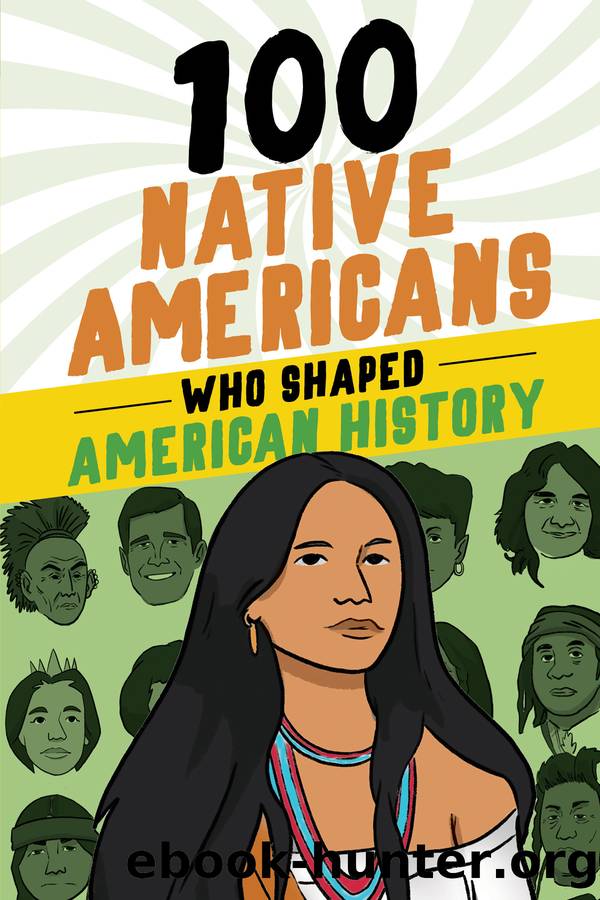100 Native Americans Who Shaped American History by Bonnie Juettner

Author:Bonnie Juettner
Language: eng
Format: epub
Publisher: Sourcebooks
53
GERTRUDE SIMMONS BONNIN
1876â1938
â¦â â Writer and activist GERTRUDE SIMMONS BONNIN helped bring about important reforms in U.S. policy toward Native Americans.
Gertrude Simmons was born on the Yankton Sioux Reservation in South Dakota, in the same year as the Battle of the Little Bighorn. She grew up at a time when U.S. Indian agents and missionaries were pushing Native Americans to give up their culture. Simmons and her mother resisted this process.
Against her motherâs wishes, however, Simmons enrolled in a boarding school run by Quaker missionaries. She did not speak English, and teachers beat students if they spoke Sioux, so Simmons had a difficult time there. She learned English, however, and remained at the school for several years.
Simmons then enrolled at Earlham College and began studying to be a teacher. She taught briefly at Carlisle, a school for Native Americans in Pennsylvania. She left the school, though, because its founder believed that Native Americans should be trained as farmers or laborers, not educated in academic subjects.
Simmons moved to Boston, and while there she began submitting short stories and essays to magazines, using the pseudonym Zitkala-Sa, or Red Bird. She was published in several national periodicals, including Harperâs magazine and the Atlantic Monthly. In her writings, she criticized the educational practices of white reformers.
In 1902 Simmons married Richard Bonnin, who like Simmons was a Nakota, or Yankton, Sioux. They moved to Utah, where they both worked for the Bureau of Indian Affairs. Disturbed by the poverty she saw on reservations, Bonnin began working with the Society of American Indians. She became SAIâs secretary and moved to Washington, DC, so she could lobby Congress on its behalf.
Bonnin resigned from SAI in 1920, but she continued to work as an activist. During the 1920s, she persuaded a womenâs club to form the Indian Welfare Committee. This committee studied reservation living conditionsâwhich in many cases were severely poorâand pressured the U.S. government to conduct a follow-up investigation. As a result, Congress hired a research firm that verified many of the Indian Welfare Committeeâs findings. The firmâs report, called the Meriam Report, led to important reforms in government policy.
At the same time, Bonnin was working with the Indian Rights Association to study the theft of land from Native Americans in Oklahoma. In 1924 she cowrote an exposé showing that swindlers had tricked many Native Americans into giving up land on which oil had been discovered.
During Bonninâs lifetime, Congress did pass some of the legal reforms she had worked so hard to bring about. In 1924 Native Americans were granted U.S. citizenship. In 1934 Congress allocated money to pay for healthcare and schools on reservations.
Download
This site does not store any files on its server. We only index and link to content provided by other sites. Please contact the content providers to delete copyright contents if any and email us, we'll remove relevant links or contents immediately.
Saint José: Boy Cristero Martyr (Vision Books) by Fr. Kevin McKenzie(193)
New York-FM-blues by New York(168)
John Steinbeck by Milton Meltzer(156)
My Dear Older Sister 05 by Unknown(156)
Extraordinary Women In History: 70 Remarkable Women Who Made a Difference, Inspired & Broke Barriers by Leah Gail(155)
Harlem Renaissance Artists and Writers by Wendy Hart Beckman(146)
The Fun of It by Amelia Earhart(146)
Dodger's Guide to London by Terry Pratchett(146)
My Dear Older Sister 03 by Unknown(132)
My Dear Older Sister 04 by Unknown(130)
My Dear Older Sister 06 by Unknown(127)
100 Native Americans Who Shaped American History by Bonnie Juettner(126)
My Dear Older Sister 02 by Unknown(124)
Native Women of Courage by Kelly Fournel(121)
My Dear Older Sister 09 by Unknown(121)
Girls Who Run the World by Diana Kapp(118)
The Epic Mentor Guide by Illana Raia(116)
Taylor Swift by Kelly Spence(113)
John and William Bartram by Sammons Sandra Wallus;(106)
